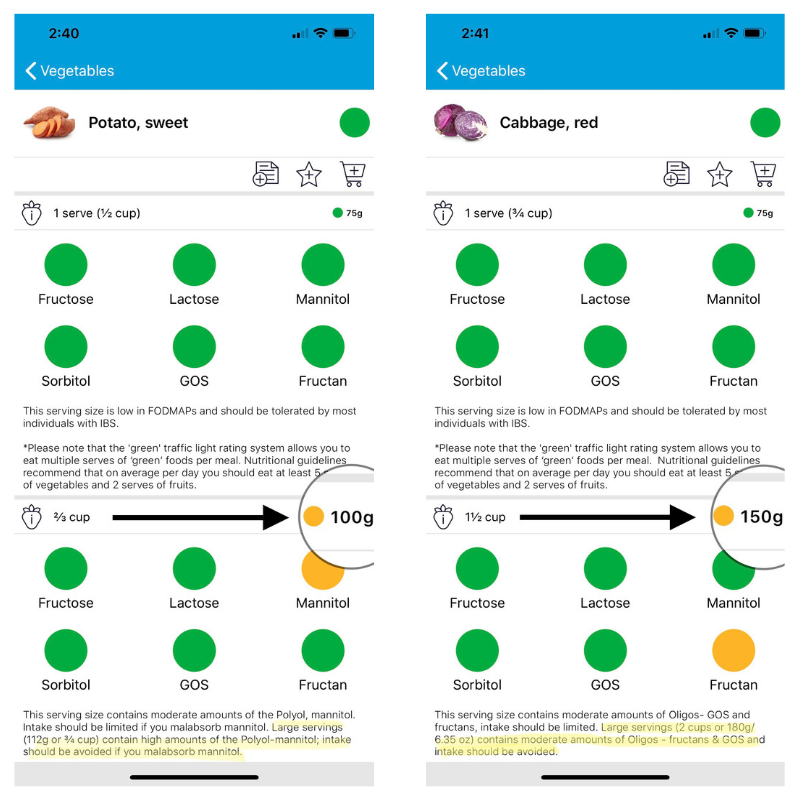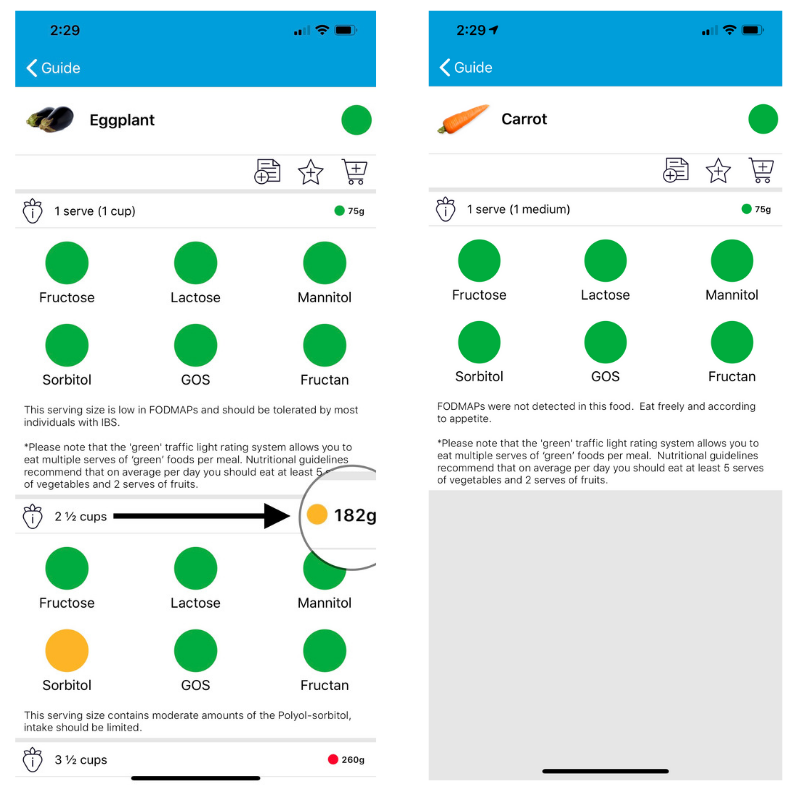
With the increasing amount of detail we share with you via our Monash FODMAP diet app, we are getting more and more questions about FODMAP stacking. You will notice that an additional set of smaller traffic lights on the app now provides more detailed serving size information for most foods. These smaller traffic lights reveal when a food with an overall green or low FODMAP rating in a typical serving size (i.e. a large 'green' traffic light) may become moderate (amber) or even high (red) in FODMAPs in larger amounts.
Sweet potato and red cabbage are good examples of this:

A standard serve of sweet potato, ½ cup (75g), is low in FODMAPs, so given an overall green light on the app. But you can see that additional serving sizes are listed next to smaller traffic lights and when you click into the food, revealing that servings larger than 100g, contain moderate amounts of the polyol mannitol, and that servings more than 112g are high in mannitol.
For red cabbage, a standard serve is ½ cup (75g), which is also low in FODMAPs, so rated overall as green in the app. However, the smaller traffic lights and clicking into the food indicates that servings more than 150g becoming moderate in fructans and servings more than 180g becoming high in fructans.
The important thing to know is that not all green foods have upper limit serving sizes. Many green foods are low in FODMAPs, even in very large serves. If there is no upper limit noted in the app, then you can safely eat a larger amount of these foods. This is the case for vegetables such as carrot. Eggplant however is green, but as indicated by the smaller traffic lights, larger quantities are amber due to a moderate amount of sorbitol and that very large amounts eventually become red or high in sorbitol.

The questions that come with this information are around FODMAP stacking. Can I eat ½ cup sweet potato, ½ cup red cabbage and 1 cup of eggplant (all of which are green in these quantities) all together in the one sitting? Is there an additive effect?
For the vast majority of IBS patients following a low FODMAP diet, this sort of example will be tolerated. Even if the total FODMAP content goes above the green limit, most people manage to eat amber and even the lower limit of red serves of foods. Should you FODMAP stack during step 1 of the diet? You should feel comfortable eating reasonable portions of green foods in one sitting, but don’t be disheartened if you eat a larger amount. It will not undo all of your good work. Most people won’t get symptoms from these type of foods. It’s the really high FODMAP foods that create the most havoc, such as onions, dried legumes and pears.
For foods with upper limit serving sizes, you can modify your meals to ensure your serving size is controlled. Sweet potato soup is unlikely to be well tolerated if it is made purely out of sweet potato and you eat 2 cups of it. But a modification of the recipe to bulk the sweet potato out with parsnip, potato and carrot (all of which are green regardless of how much you eat), the end result will be a low FODMAP sweet potato soup.
In the end, we want you to remember that a FODMAP diet should be personalised over time include green and amber serves of foods (and for some people even many red serves of foods), according to your own level of tolerance. So, you can consume larger servings of foods that may bring them into moderate or high FODMAP levels as long as your symptoms are tolerable.
We are more than happy to provide some guidance with further FODMAP stacking questions. What sort of food combinations have you been concerned about? Post them on facebook and we will provide some guidance on whether they are OK, and how you could modify your meal to lower the FODMAP content.